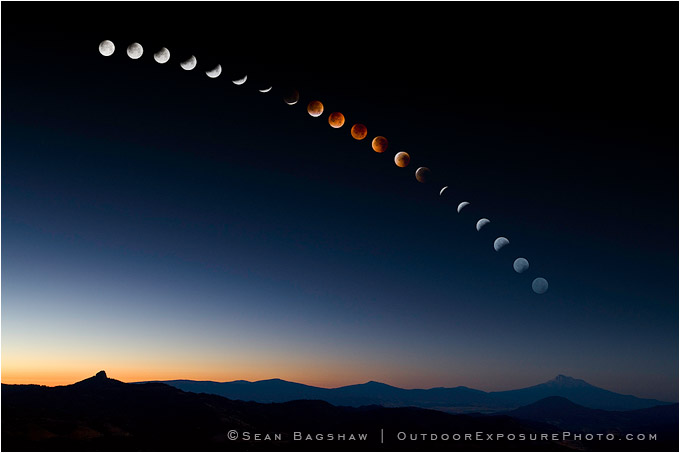By Sean Bagshaw
A recent visitor to the Photo Cascadia website was curious about how I created the image “Lunar Eclipse Over Mt. Shasta”. This image always generates interest and some good discussion. I figured that others may have similar questions, so I am posting my response here for one and all.

Lunar Eclipse Over Mt. Shasta
The story of “Lunar Eclipse Over Mt. Shasta” started the day before the total lunar eclipse that occurred on August 28, 2007. I had been out of town on a photo trip and had no idea a lunar eclipse was about to happen. A photographer friend called me to ask if I planned to photograph the eclipse, to which I responded, “I am now that I know about it”. He and I made plans to spend the next night shooting from a location in the Siskiyou Mountains above Ashland, Oregon. Having no experience photographing eclipses, I decided that I should probably do some reading on how best to approach it.
I found a lot of information on exposure times, camera settings and focal length needed to get nice close single shots of the moon during the eclipse. I also found photo montages showing several closeups of the moon in various stages of an eclipse composited together in various ways. However, the images that I found most intriguing were multiple exposure time lapse images in which the complete arc of the moon during the eclipse is shown in 10 to 15 minute increments. The best of these included some sort of landscape reference in the photo, such as a horizon, mountains, trees or buildings. It was cool to see the moon in context with the thing that was casting the shadow on it, not just floating in a black sky. I really liked the power of showing all six hours of its passage through the Earth’s shadow in a single two dimensional image.
The one thing that took away from these multiple exposure images however (all done with film at the time), was that the moon appeared as a mere dot in the sky and the details of the eclipse were almost imperceptible. The reason for this is that with film, the entire arc of the moon during the event had to fit on a single frame of film without moving the camera. This meant that photographers using this technique had to use wide angle lenses that could encompass the entire event in one frame. With such a wide angle lens, the moon appears very small in the scene.
I realized that I could use digital technology to my advantage to incorporate the different techniques I had read about and create a final image that showed the entire event in context with the Earth, the way I wanted, but with good moon size and eclipse detail as well. For six hours I photographed the progression of the eclipse with a 400mm lens on a Canon 20D. This enabled me to get good, sharp close-ups, but the moon would begin to move out of the frame every few minutes, so I continuously re-aimed my camera to keep up with it. During the six hours I took about 200 shots of the moon to make sure that I had captured everything and that I had the exposures right. Just after the eclipse ended, twilight from the rising sun began to show in the east. I switched to a wider angle lens and took some landscape images of the orange glow on the horizon leaving lots of sky in the frame in which to later place the images of the moon.
Back home on the computer I went through all 200 eclipse images and selected out the 20 that I felt best represented the progression of the event in even increments. I then carefully cut, pasted, sized and arranged each of them in an arc across the sky of my background image to create the final piece.
The photo is not a literal record of the eclipse, but then anything short of a six hour long video wouldn’t be. The arc of the moon and the distance the moon travels between each exposure in my image were entirely fabricated by me to achieve what I felt was the best artistic composition and visual impact. Astronomy buffs can also quickly point out that a lunar eclipse always occurs during a full moon when the moon is located directly opposite the sun in the sky, so there is no way that an eclipse could be seen in the morning twilight with the sun rising directly behind it. From the beginning, my main goals were to create something visually exciting that told the story of the eclipse with enough detail to capture the imagination and perhaps allow people to experience it in a way they otherwise could not. The ability to manipulate time and space to create a vision of reality that we can’t normally perceive on our own is one of the great powers of photography.
At the time I took the image I was just having fun with the experiment and didn’t think too much about it beyond that. However, now, when I consider that I may only see a handful more total eclipses in my life and realize the slim chance that one of those would occur on a cloudless night with crisp skies and take place in the center of the sky so that no part of the eclipse is lost behind the horizon, I’m really glad I didn’t screw it up.
If you have other questions about this photo or other Photo Cascadia images, feel free to leave a comment or contact the team.

Recent Comments